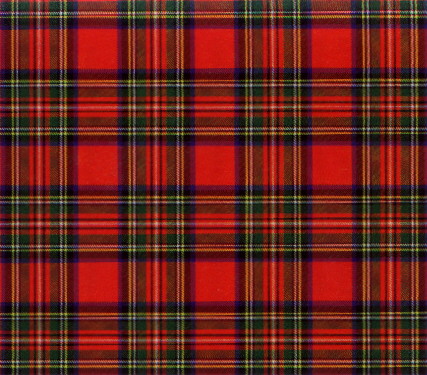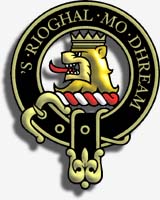The Antagonists
(Campbells, Stewarts and their ilk)
![]()
![]()
CAMPBELL
(of Argyll)

Tradition has it that this clan descended from a Duibhne, or "Diarmid" in English. The Diarmid connection was obtained through a marriage, as was so often the Campbell 'modus operandi'. The clan was originally called the clan Diarmid, until 1263, when a 'Gillespie Campbell' was mentioned in a charter.
In 1292, Sir Colin Campbell of Lochawe was recognized as the founder of the Campbells of Argyll, and the Gaelic form of his name - Cailean Mor - was incorporated into the title of all subsequent Campbell Chiefs. Sir Colin was slain by the MacDougalls of Lorne in 1296, but the clan prospered under his son, Sir Neil Campbell.
Neil was a loyal supporter of, first, William Wallace, then Robert the Bruce, and as a result, King Bruce gave his sister to a Campbell in marriage. Their support against Bruce's enemies was rewarded with extensive territories in the west Highlands, especially from the MacNabs and some MacGregor lands.
The MacGregors were not the only clan to suffer  under Campbell depredations; one such misdeed will
live forever in the annals of shame in Scottish history. In 1692, to set an example to all
Highlanders, William sent a Campbell military expedition into the MacDonald territory of
GlenCoe, where thirty-six men, women, and children were murdered in their beds after being
deceived by the soldiers as being friendly. The Campbells were universally condemned
for this outrage, not because of the body count but because of the violation of the
ancient Scottish 'Code of Hospitality.'
under Campbell depredations; one such misdeed will
live forever in the annals of shame in Scottish history. In 1692, to set an example to all
Highlanders, William sent a Campbell military expedition into the MacDonald territory of
GlenCoe, where thirty-six men, women, and children were murdered in their beds after being
deceived by the soldiers as being friendly. The Campbells were universally condemned
for this outrage, not because of the body count but because of the violation of the
ancient Scottish 'Code of Hospitality.'
There were many other such murderous incidences where Campbell Lords acted in their own self interest. Archibald Campbell, 8th Earl of Argyll, was executed in 1661 by Charles II, not for his depredations against the MacGregors, nor his treason against the Stewarts, but on ample proof for his betrayal, treachery, perjury and massacre of the Lamonts of Cowal. Archibald's son, the 9th Earl, was also executed in 1685 for treason.

Campbell troops watching a GlenCoe village burn
Campbells versus MacGregors
The MacGregors were the most famous victims of the expansion of the Campbells. Although this gained its greatest momentum after the downfall of the Lords of the Isles (Clan Donald), the misfortunes of the MacGregors began much earlier.
The MacGregor Chief, Iain was captured by the English King in 1296 and was forced to promise to be his vassal. He died without a male heir, so his daughter, who had married a Campbell, passed the Chieftanship on to her husband. This was seen as a mere ploy by the Campbells to subjugate the MacGregors, so Gregor MacGregor, a nephew of Iain, set himself up as the leader of the Clan and was determined to hold it by the sword.
The MacGregors were neighbours of the MacNabs and were related through the male line. The MacNabs fought against the Bruce after his treachery against Wallace and the murder of 'Red" Comyn. They succeeded in attracting some MacGregor clansmen to their cause, so when they were defeated, both clans lost lands to the Campbells by Royal decree.
Bruce left it to the Campbells as to how they would enforce his mandate. Therein began a long and bitter feud between the Campbells and the MacGregors. The Campbells had on their side the precepts of justice and the sympathy of the King. The MacGregors had only their Gaelic-clan friends and their own resourcefulness.
The original MacGregor homeland of GlenOrchy, ( which had been ceded to them by King Alexander for the clan's assistance in defeating the Norse), was ceded to the Campbells by Bruce, forcing the MacGregor Chiefs to retreat to GlenStrae. MacGregor strongholds fell one by one to the Campbells, who bestowed upon themselves titles to MacGregor lands and estates, ( i.e. Duke of Argyll, Earl of Breadalbane, Lord of GlenOrchy, etc. etc.).
The Campbells indulged in rewriting history, eliminating any reference to MacGregor achievements; i.e. Kilchurn Castle is represented in 'Scottish Clans and Tartans' page 41, (written by Ian Grimble); "Sir Colin (Campbell) of GlenOrchy married Margaret Stewart, one of the co-heiresses of the Stewart family, and thus obtained the properties that enabled him to build the castle of Kilchurn in about 1440 and to found the cadet branch of the Campbells of Breadalbane.", - however in Forbes MacGregor's "Clan Gregor" he writes on page 47; "By 1440, they had lost most of their Argyllshire lands, including Kilchurn Castle, one of their ancient strongholds, on the accessible east side of Loch Awe."
The truth is in Sir Walter Scott's epic poem 'The MacGregors Gathering' (3rd verse);
Glen Orchy's proud mountains, Kilchurn and her towers, Glenstrae and Glenlyon no longer are ours; We're landless, landless, landless, Gregarach!
Author's Note: Such politically motivated revamping of the past is not restricted to the Soviets or to other modern day revisionists; most of the present day population of Scotland are totally ignorant of any MacGregor accomplishments or of the true nature of the criminal government-sponsored genocide which was universally visited upon the MacGregors for over 400 years. On a tour of a Scottish historical site, a guide stated that she was doubtful that a Rob Roy MacGregor had actually existed. This in spite of overwhelming evidence to the contrary and his actual gravesite at Balquhidder churchyard.
In 1519, the Campbells set up a puppet line of Glen Orchy MacGregor Chiefs to rival the true GlenStrae line. By 1552, the GlenStrae Chief and his three sons were all murdered by Campbells, although a grandson survived until he too fell to a Campbell sword in 1604.
By then, the entire clan had been outlawed and it was a capital offence to bear the name. The Campbells saw to it that the remaining MacGregors were hunted by dogs like vermin. To give aid to a MacGregor was a criminal offence, and Scottish records indicate that many MacGregor sympathisers were heavily fined until 1774, when the proscriptions were finally lifted.
![]()
STEWART
(STUART)

The Long Road to the Throne
The Stewarts descended from a family who were estte managers in Brittany, France. They acquired estates in England after the Norman conquest and, Walter Flaad moved to Scotland when David I claimed the throne. He became the High Steward of the royal household, a hereditary post that gave the clan its name.
Walter was granted land in Renfrew and Paisley, and took part in the successful campaign against Somerled of the Isles (1164). James, the 5th High Steward, supported Wallace, then Bruce in their campaigns against England. Walter, 6th High Steward married Bruce's daughter, Marjory. In due course, this match brought the Stewards the crown, for, when David II died childless, Marjory's son ascended the throne as Robert II (1371). After this, the Stewards ruled Scotland for 300 years.
A Reverse Take-over of England
In 1537, the Earl of Lennox adopted French nationality and decided to spell his name as "Stuart", since this version was easier for his new compatriots to pronounce. Gradually this version began to replace the familiar Scottish version.
The destiny of the house of Stewart underwent a dramatic transformation during the middle of the 16th century. As the country's political fortunes shifted rapidly, its leaders faced a daunting prospect: they might soon unite three royal thrones - the kingdoms of England, France, and Scotland - or else be left with nothing.
Upon the death of James V, the young Princess Mary became Queen and was soon courted by Henry VIII of England and the Dauphin of France. The Queen was married off to the Dauphin, who ruled France for one year as Francois II. Mary subsequently married twice and soon became a widow thrice over.
The new Queen Elizabeth of England was having legal difficulties as Catholics in all countries did not recognise her as legitimate. Mary had a better claim through her grandmother, Margaret Tudor. Ultimately this accident of birth would lead to the downfall of the Scottish Queen.
Mary gave birth to a son, James, in the summer of 1566. In July 1567, he was crowned King James VI of Scotland. Mary's disastrous marriages to courtiers turned her people against her and after a series of military defeats, she fled to England.
Elizabeth imprisoned her for 19 years before beheading her. On Elizabeth's death in 1603, James was proclaimed King James I of England. For the first time, a Scottish monarch had taken possession of the English throne.
This Scottish takeover of England became in effect a reverse takeover, as the two countries would be irreparably joined at the hip no matter what ensued. Scotland was now doomed to be a junior partner in the new union, with English laws and interests gradually overwhelming and supplanting those of Scotland.
Setting Lowlanders Against Highlanders
On the whole, the Stewart monarchs were intelligent and ruthless, both useful qualities in a sovereign. To assert the authority of the crown was the constant endeavour of the king and to this end the Stewarts were prepared to employ any means. Perhaps the greatest criticism of the Stewart monarchy as a whole is that, far from uniting Highlands and Lowlands, it perpetuated and aggravated the division between the Gaelic-speaking north and the English-speaking south.
Conciliation was tried occasionally, usually when force was impracticable, but the culmination of the Crown's efforts to bring the whole country under its thumb was the deliberate, often brutal suppression of Gaelic culture. Highlanders were, for a period, prohibited from wearing their traditional kilts and from playing the bagpipes.
The Stuart dynasty had openly chosen the Lowland way of life to be that of a future Scotland, at the expense of the very people who would eventually become the pillar of the Stuart cause. However, the seeds of destruction were implanted into Lowland society with the advent of English Protestantism and its revolutionary concepts.
The Lowlands gradually became predominantly Protestant and the Highlands remained solidly Catholic - with the exception of some southerly clans, amongst them, the Campbells. As the Stuarts remained staunchly Catholic, this situation led to disloyalty of the most powerful Lowland Clans and the eventual alienation (of the Stuarts) by the English establishment.
The Catholicism of Charles Stuart I begat the great British Civil War and ended with his execution. His grandson, Charles II, turned to diplomacy and discretion to maintain his power in England. In Scotland he was ruthless in eradicating any signs of Protestantism. During his reign, the MacGregors enjoyed a brief respite from the Campbells. Instead, it was the Campbell's turn to run and hide - for awhile.
Almost every Stuart sovereign remains to this day a subject of lively controversy. What is beyond dispute is their failure to integrate the Gaelic (Highland) half of their kingdom with the English-speaking (Lowland) half from where they ruled it. For the most part they treated its Gaelic peoples with an incompetence and a savagery that does little credit with their fabricated Celtic origins. Only when the Stuarts had been rejected by their English speaking subjects did they fall back on the Gaels for support - and thus complete the ruin of both.
After William of Orange became King, the Campbells returned as court favourites and advisors on the Scottish 'problem', that is the 'chronic lawlessness and papist sympathies' of the Highlanders. Revenge was quick and ruthless; with the Campbells back in positions of power, it was the Protestant's turn to blacken the countryside.
Making An Example of The MacGregors
While the Kings of Scotland had an interest in maintaining a strong Clan system, even at the expense of certain niceties of fair-play, when James ascended the throne of England, an entirely new circumstance arose. He could not allow a 'lawless' clan to usurp his authority at home. He had to present an aura of authority now that he had the support of an entirely new and much larger army. James was an extreme Scottish nationalist, and would not tolerate any criticism of things Scottish, although he chose to move his domicile from a cold and draughty Edinburgh to a warmer and friendlier London.
With Campbell advisors and their own agenda uppermost, James decided to make an example of the MacGregors. Their name was proscribed and their lands confiscated, - of course to the benefit of adjacent Campbell and Stuart Lairds. Four times, the MacGregors were the victims of state-sponsored genocide on a grand scale. Still they persisted in their mountain fastness and deep in their Glens. Bounties were placed on MacGregor scalps, and they were hunted down sothat destitute Highlanders could pay their exorbitant rents - to Campbell and Stuart landlords.
Colquhoun

When King James I returned to Scotland in 1424, from his long captivity in England, he set about annihilating his enemies. Among those was the Earl of Lennox, whose family he destroyed. Into the vacuum stepped Iain of Luss, appointed by James I to capture and hold Dumbarton Castle, once the capital of the Briton (Gaelic Welsh) kingdom of Strathclyde.
In 1427, he was made Sheriff of Dumbarton. However, in 1439, Luss met his death on the island of Inchmurrin in Loch Lomond at the hands of the MacLeans of Duart. His grandson was compensated by James II, who erected Luss into a free barony in 1457, with a capital jurisdiction that his descendants continued to exercise until after the battle of Culloden.
Amelia Georgiana Murray MacGregor, writing in 1898 in the "History of the Clan Gregor," states that MacGregor of Ardinconnell, one of the oldest offshoots of the clan, was the branch most involved in the disputes with Colquhoun of Luss. The earliest record of any dispute is a Deed of Resignation dated February 7th, 1429, transferring Gleane Mackerne (Glen Mackurn) to Iain Colquhoun of Luss. Documents signed throughout the 1400s and 1500s indicate that the Colquhouns, like the Campbells, wanted the MacGregors' lands and, with numerous Royal decrees were largely successful in their efforts.
One of the most notorious episodes in the clan's history is the conflict with clan Gregor which occured during the lifetime of Alasdair Colquhoun, 17th of Luss. The dispossessed MacGregors were forced to live by raiding the lands of others. After an incident when a band of MacGregors were caught stealing sheep in Colquhoun property, some Colquhoun women brought the blood stained shirts of their menfolk (and, it is widely said, others dipped in the blood of sheep) to James VI.
A few months later, the Colquhouns armed with a Royal warrant, set off for MacGregor country to seek revenge. The MacGregors were notified of the expedition, and 400 set off to meet them at Glen Fruin, where a narrow passage restricted the use of horses, of which the Colquhouns had aplenty. Although outnunbered, the MacGregors were successful in surprising the Colquhouns, Buchanans and several scores of Dumbarton townsmen.
One hundred and seventy of the Colquhouns were killed opposed to only one MacGregor fatality. The Colquhounhorses were sent back to Dunbarton carrying the severed heads of their riders. Adding to the slaughter, were several boys who went to watch the battle. Their captor was a MacIntosh, ( who acted on his own and was eventually hunted down and executed), but Alasdair MacGregor accepted ultimate responsibility for the carnage.
Betrayed by the Campbell Duke of Argyll, Alasdair was hanged in Edinburgh. The MacGregors were given the most severe proscription ever awarded a clan in British history for their efforts to protect themselves from an officially sanctioned murder campaign by the Colquhouns.
In a touch of irony, the house of Luss and all its property passed to a branch of the Clan Gregor in 1718, when the heiress Anne Colquhoun of Luss married the Chief of the Clan Grant (descended from Gregor Mhor MacGregor, who lived in the 12th century.)
Galbraith

This name derives from the Gaelic for "foreign Briton." This family migrated from the Welsh kingdom of Strathclyde into Celtic territory in 1208 - 1214AD. The first Galbraith Chief was 'Gilchrist Bretnach', and he married a daughter of the Earl of Lennox. The family stronghold was on InchGalbraith, an island in Loch Lomond.
Galbraith fortunes varfied in symmetry with the house of Lennox. When James I sacked Dumbarton, the Galbraith Chief fled west to Kintyre with 600 Galbraiths. Thomas the 12th Chief took up arms against the King, and was hanged in 1489. His brother escaped and received a Royal pardon later.
Robert Galbraith, the 17th Chief, proved to be a drunken scoundrel who brought nemisis upon his house. In 1592, he sought and received a commission to pursue the Clan Gregor. He misused his powers to persecute the Chief of the Clan MacAuley,(a branch of the Clan Gregor). (The elderly Chief had married Robert's widowed mother against his wishes.)
His subsequent misdeeds led finally to his being arrested and denounced as a rebel. In 1622, he fled from an order for his arrest, and died in Ireland sometime before 1642. His heir inherited nothing and his grandson James, the 19th Chief, is the last traceable member of his line.
Given the sad fate of most of our allies, it is surprising that the MacGregors, the most victimized of all the clans by the Campbells and the Stewarts, has survived.
It is a reflection of our unique stubbornness in the face of horrible oppression that we were not wholly absorbed by our nemesis. God only knows they tried.
May I make an ancient toast to our family?
Up the
MacGregors!!!
![]()
![]()